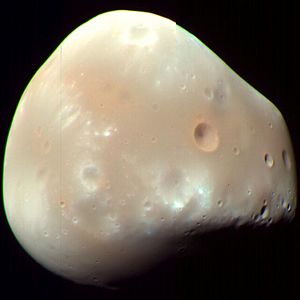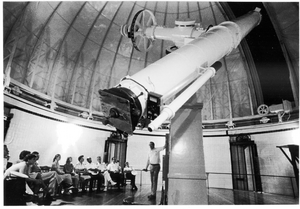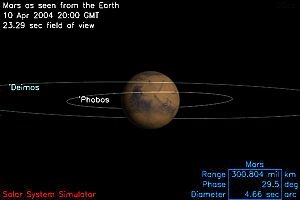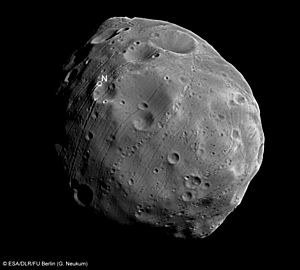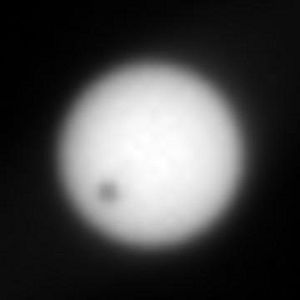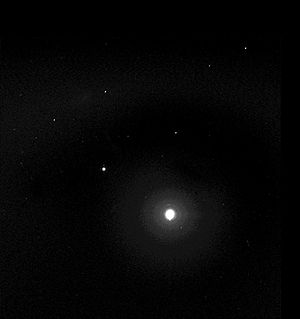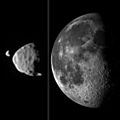Deimos (moon) facts for kids
|
An enhanced-color image of Deimos (MRO, 21 February 2009).
Image: NASA/JPL-Caltech/University of Arizona |
|
| Discovery | |
|---|---|
| Discovered by | Asaph Hall |
| Discovery date | 12 August 1877 |
| Designations | |
| Mars II | |
| Adjectives | Deimosian |
| Orbital characteristics | |
| Epoch 2012-Sep-21 (JD 2456191.5) |
|
| Periapsis | 23455.5 km |
| Apoapsis | 23470.9 km |
| 23463.2 km (6.92 Mars radii) | |
| Eccentricity | 0.00033 |
| 1.263 d (30.312 h) |
|
|
Average orbital speed
|
1.3513 km/s |
| Inclination | 0.93° (to Mars's equator) 1.791° (to the local Laplace plane) 27.58° (to the ecliptic) |
| Satellite of | Mars |
| Physical characteristics | |
| Dimensions | 15 × 12.2 × 11 km |
|
Mean radius
|
6.2 ± 0.18 km (0.97316 mEarths) |
| 495.1548 km2 (97.0755 µEarths) |
|
| Volume | 999.78 km3 (92.2979 nEarths) |
| Mass | 1.4762×1015 kg (0.247179 nEarths) |
|
Mean density
|
1.471±0.166 g/cm3 |
| 0.003 m/s2 (306 µg) |
|
| 5.556 m/s (20 km/h) |
|
| Synchronous | |
| Albedo | 0.068 ± 0.007 |
| Temperature | ≈ 233 K |
| 12.89 | |
Deimos is the smaller of the two moons orbiting the planet Mars. Its sibling moon is called Phobos. Deimos is one of the tiniest moons in our Solar System. It is about 6.2 kilometers (3.9 miles) wide. Deimos takes about 30.3 hours to go around Mars. It orbits much farther from Mars than Phobos does, about 23,460 kilometers (14,580 miles) away. Deimos is named after a character from Greek mythology, who was the twin brother of Phobos.
Contents
Discovery of Deimos
Deimos was found by Asaph Hall at the United States Naval Observatory in Washington, D.C.. He discovered it on August 12, 1877. Hall also found Phobos just a few days later, on August 18, 1877. He had been actively looking for moons around Mars.
The name Deimos comes from Greek mythology. It means "dread" or "terror."
Scientists are still unsure how Mars's moons were formed. One idea is that they were once asteroids that got too close to Mars. Mars's gravity might have pulled them into orbit. Another idea is that they formed from dust and rocks that came together around Mars. This is called accretion.
What Deimos is Like
Deimos's Orbit
Deimos travels in a path around Mars that is almost a perfect circle. Some scientists think Deimos might have been an asteroid. It could have been pushed by Jupiter into a path that allowed Mars to capture it.
If you were standing on Mars, Deimos would look like a bright star. When it's at its brightest, like a "full moon," it would shine as brightly as Venus does from Earth. With a small telescope, an observer on Mars could even see Deimos go through its different phases.
Deimos rises in the east and sets in the west, just like our Moon. It takes about 5.5 days for Deimos to rise, set, and rise again. Deimos is slowly moving farther away from Mars. This is because of something called tidal acceleration. Eventually, it is expected to escape Mars's gravity completely.
Deimos's Surface
Deimos is made of dark, rocky material that has a lot of carbon. This material is similar to a type of meteorite called carbonaceous chondrite. Its surface is covered in craters, but it looks smoother than Phobos's surface. This is because dust and loose rocks, called regolith, have partly filled in the craters. This regolith is very porous, meaning it has many tiny holes.
Only two craters on Deimos have been given official names. They are called Swift and Voltaire. These names honor writers who guessed that Mars had two moons before they were actually discovered.
No Atmosphere
Deimos does not have an atmosphere at all. Its surface is covered in craters from meteor impacts, much like Earth's Moon. The rocks on Deimos are very dark. Scientists have also found water ice on Deimos, both on its surface and inside.
Gravity on Deimos
Because Deimos is so small, its gravity is extremely weak. It's about 2,500 times weaker than Earth's gravity. This means if you were on Deimos, it would be very easy to jump right off the moon! Astronauts would need special tethers or restraints to keep them from floating away. If a base were built there, it would feel more like living inside a space station.
Solar Transits
Deimos often passes in front of the Sun when viewed from Mars. It is too small to cause a total eclipse, so it just looks like a tiny black dot moving across the Sun. Mars rovers have even taken pictures of these events. For example, the Opportunity rover photographed a transit on March 4, 2004. The Spirit rover also captured one on March 13, 2004.
Exploring Deimos
Scientists are very interested in exploring Deimos because they believe it might be a captured asteroid. By studying Deimos and Phobos up close, they hope to learn more about other asteroids in our Solar System.
Many spacecraft have photographed Deimos while their main mission was to study Mars. So far, no spacecraft has ever landed on Deimos.
The Soviet Union sent two probes, called the Phobos program, to study Phobos in 1988. If the first probe, Phobos 1, had worked, Phobos 2 might have gone to Deimos. Both probes launched successfully, but Phobos 1 was lost. Phobos 2 sent back some data and images but stopped working before it could fully explore Phobos.
In 2008, NASA began looking into a mission to bring samples from Phobos and Deimos back to Earth. This idea led to the "Hall" mission concept. Another mission idea, called Gulliver, would aim to bring back about 1 kilogram (2.2 pounds) of material from Deimos.
In 2014, a new mission called Phobos And Deimos & Mars Environment (PADME) was suggested. It would send an orbiter to Mars by 2021 to study both Phobos and Deimos.
Some scientists think that exploring Deimos could be a first step for humans to explore Mars. It has even been suggested that the dust from Deimos or Phobos could be useful for future Mars colonies.
Images for kids
-
The surface of Deimos from 30 km (Viking, 1977)
-
Orbits of Phobos and Deimos (to scale)
-
Curiosity's view of the Mars moons: Phobos passing in front of Deimos in real-time (video-gif, 1 August 2013)
-
Deimos and Phobos as seen from Mars, compared to the Moon as seen from Earth (in angular sizes)
-
Deimos imaged by one of the Viking orbiters
See also
 In Spanish: Deimos (satélite) para niños
In Spanish: Deimos (satélite) para niños


